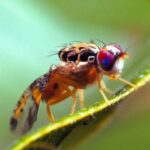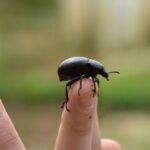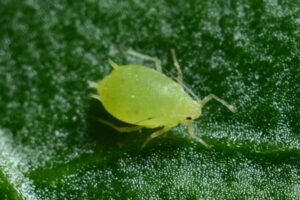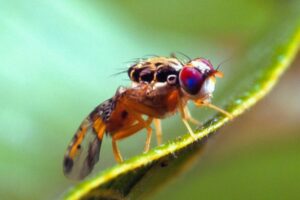Are you wondering what those small black flying bugs in your house are? You are sure they are not fruit flies because they are too small. So what do you call these small black flying bugs in the house?
Often mistaken for fruit flies, fungus gnats can also sometimes get into most homes. The reason is they feed on the same things that flies do. Fungus gnats are almost half the size of regular house flies and have completely black bodies. You can see fungus gnats drawn to rotting organic matter like fruit flies.
Read on to learn more about the small black flying bugs in the house and how to get rid of them.
Small Black Flying Bugs in the House
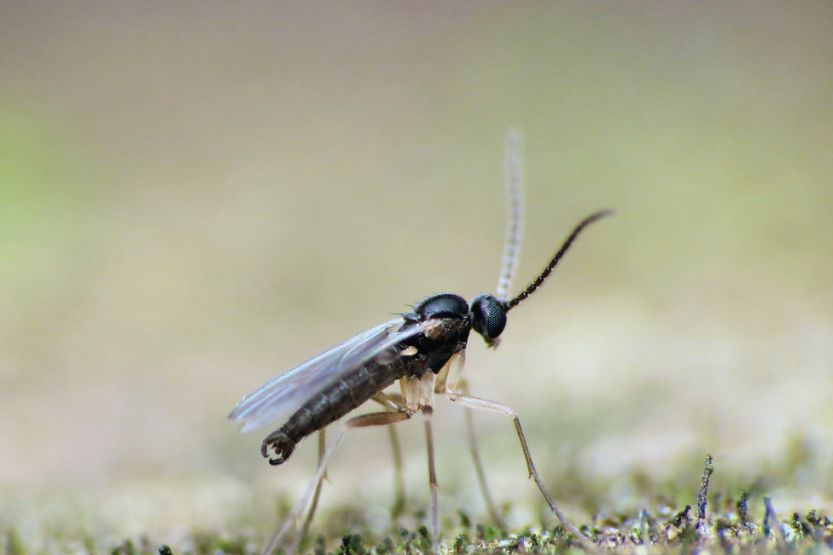
Do you currently have a small infestation of small black flying bugs in your home? At first, you thought that they were just regular house flies.
This could be until you looked closely at them and found them different. These flies are smaller, and their bodies are entirely black, so they could not be house flies. They look like mosquitoes but are too small to be those as well.
What you are dealing with in your home is likely a small swarm of fungus gnats. These insects are small flies in the kitchen that are not fruit flies.
They belong to entirely different species of insects. For one thing, fungus gnats have completely black bodies, while house flies are often brown or tan. Also, fungus gnats are much smaller than house flies, almost half the size.
Fungus gnats are tiny insects that are smaller than your regular house fly. They look like mosquitoes but smaller and do not suck on your blood.
These insects are typically visible outdoors but can also be found inside homes. You can find them in damp areas near decaying organic material. You can also often find them inside kitchen and bathroom drains and in potting soil.
Sometimes, they will even lay their eggs in your kids’ sandbox. Just like common house flies, these black bugs will come buzzing around your kitchen.
Also, just like house flies, fungus gnats can reproduce quickly. You need to find out where they are coming from to prevent them from thoroughly infesting your house.
Small Flies In House All of a Sudden
What Other Small Black Flying Insects Could be In Your House?
Aside from fungus gnats, other possible small black flying bugs in the house that are not fruit flies. Among them are the following:
1. Clothes Moths

Although these are usually greyish, most of them are very dark, and they almost look black. These tiny flying bugs in the bedroom at night have less than a ½-inch wingspan. They are pretty problematic as they usually eat fabrics.
2. Drain Flies
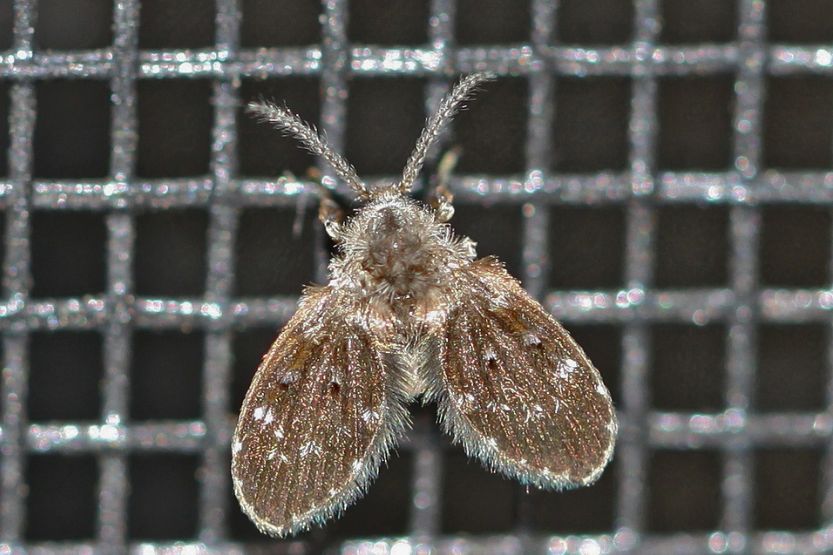
These look like tiny moths. They are gray and have a fuzzy texture.
3. Carpet Beetles
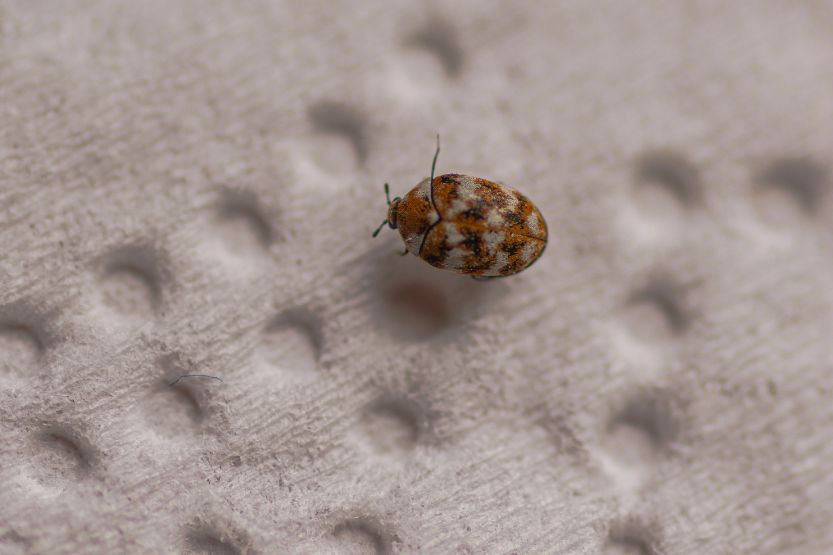
These bugs are less than a ¼-inch in length. They can also be red, brown, or black. You can usually find them around window sills, lamps, and usually in between the slats of old wood flooring.
4. Flying Ants

These are the males and sexually mature queens of any ant colony. The queens are the larger of the pair. Sometimes, they can reach 15mm in length, depending on the ant species.
They usually come out of their nests in the ground during the hottest parts of the summer. You can also see them swarming around bright lights all the time.
5. Pantry Moths
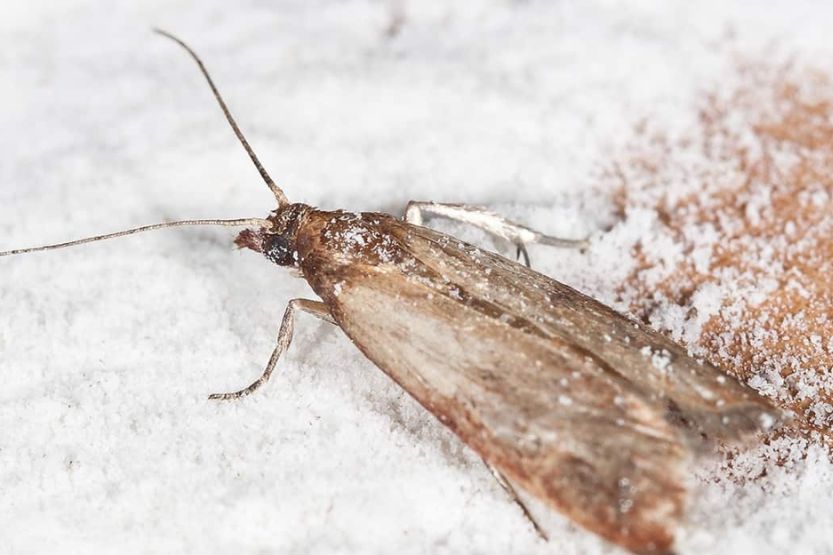
These small flies in the kitchen that are not fruit flies got their name because they usually infest dry food items. These include rice, cereal, flour, cornstarch, etc. The insects are also identifiable by their fuzzy, gray wings, with mottled brown or red patterns.
What Are Black and White Ladybugs?
What Attracts Fungus Gnats to Your Home?
Unlike house flies that lay their eggs in rotting or decaying organic matter, fungus gnats lay eggs in the ground. The specific places are those with fungal growth.
If these gnats lay eggs in your plants’ potting mix, they will start to eat the roots of the plants. This will specifically begin with the moment the larva hatches. This results in the plant turning yellow and dying.
Although fungus gnats are usually outside, they can also find their way into your home. Here are the reasons why:
1. Moisture
Fungus gnats love hanging out around overwatered houseplants, specifically the stagnant water in the pot liners.
You can also find them in places where there is standing water, like kitchen and bathroom sinks. If you have houseplants, give them a slight tap. If there are gnats in there, they will start flying out of the plant.
2. Rotting Organic Matter
Just like house flies, fungus gnats like to feed on decaying organic matter. However, they only prefer plant matter.
This is why you should remove dead leaves and other plant debris inside the pot when you have houseplants. Fungus gnats like rotting leaves, wood chips, plant stems, peat moss, and fruits.
3. Bright Lights
Just like most insects, fungus gnats swarm around bright lights, like light bulbs. If you have no external lights in your garden, they will find a way to get into your home.
4. Carbon Dioxide
Like house flies, mosquitoes, and other small flying insects, fungus gnats like carbon dioxide (CO2). This is why fungus gnats tend to swarm around the faces of humans and animals, making them quite annoying. This is especially true if there is a somewhat large swarm of them.
How to Spot a Fungus Gnat

How do you know if what you are dealing with inside your home is a fungus gnat? Here are some things you have to check so that you can detect their presence:
Size
Full-grown fungus gnats are tiny. They can range in size from 1/16-inch to 1/8-inch in length. This is a bit smaller than a fruit fly. Their larvae, if you can find them (usually underground), measure one-eighth-inch on average.
Appearance
Fungus gnats are dark gray and have transparent wings, similar to house flies. They also have long legs and antennae, making them look like mosquitoes.
However, they are a lot smaller. Compared to a regular fruit fly, a fungus gnat has a thinner body but long legs and antennae. Their larvae, on the other hand, have small heads that are black and pale white and translucent bodies.
Behavior
Fungus gnats like to spend their days hanging out on potted plants’ soil surfaces. Sometimes, they want to buzz around bathroom and kitchen drains.
Fungus gnats, despite their appearance, are not strong fliers. They spend most of their time walking on damp soil. They can only fly for short bursts at once. Sometimes, they only do so to avoid predators.
Also, just like mosquitoes and flies, fungus gnats find carbon dioxide appealing. This causes them to fly toward peoples’ faces, particularly into the nose and mouth. Because fungus gnats are smaller than flies, they can often get inside your nose.
Do Fungus Gnats Carry Diseases?
As annoying as these tiny insects are, it is fortunate that they do not carry any diseases. Fungus gnats do not bite or sting. They do not even spread diseases.
However, this does not mean they are not problematic. If you have fungus gnats in your home, your houseplants will take the most damage.
They will lay thousands of larvae when their population explodes, which usually takes only a short time. Their favorite food is the thin roots of your plants.
In addition, fungus gnats also tend to spread Pythium. This pathogen causes a disease in plant seedlings called “damping off.”
This disease causes seedlings to weaken and die before reaching maturity. It can be problematic if you have a small greenhouse infested with these flies. If you don’t take the necessary measures, your plants will be decimated.
Again, what are the small black flying bugs in your house that are not fruit flies? Most likely, the small black flying bugs in your house are fungus gnats. Fungus gnats are smaller than a fruit fly, have a black body, and are also attracted to decaying wastes.
How to Eliminate Fungus Gnats
If you want to remove fungus gnats from home, consistency is an essential part of the process. You can catch the adult ones easily. Simple glue traps work well.
However, because their swarms come in cycles, replace your traps regularly. If you want to get rid of them, use other techniques besides glue traps:
1. Yellow Sticky Card Traps
These are the regular glue traps you can find in most hardware stores. This is just a standard yellow note card covered with sticky adhesive. To make them work more efficiently, cut them into small squares. Place them directly on top of the soil in your potted plants.
You can also tape them on the ends of wooden skewers and stick them into the soil. The adult gnats will crawl onto the glue card and get stuck. Use the yellow sticky cards as this is the most attractive color for fungus gnats.
2. Cider Vinegar Traps
These are simple yet effective traps for fungus gnats and other annoying bugs. To make a cider vinegar trap, get a shallow container.
Place equal parts of cider vinegar, liquid dish soap, and water. About a quarter-inch deep of the cider vinegar solution should be enough, but more is always better.
Place the container at the base of the houseplants that fungus gnats always visit regularly. The smell of the vinegar will attract the gnats.
The dish soap will also cause them to get stuck and poison them. Check the container regularly to dump out the contents when it is full of gnats. Continue refilling until you have eliminated the gnats in your home.
3. Flypaper Ribbons
Like how they can catch regular houseflies, flypaper ribbons can also catch fungus gnats. However, these are overkill just for catching fungus gnats. They are usually more of a hassle when used indoors.
Although these methods are effective, it is unlikely that you’ll eliminate the entire fungus gnat infestation at once.
You will likely make repeated applications to whittle at their numbers until they’re gone. It is also advisable to use more than one method to increase the chances of success.
How to Get Rid of Fungus Gnats Permanently?

Now that you have eradicated the fungus gnats in your house, you should prevent them from returning. Here are some things you can do to keep these flying black bugs from invading your home again:
1. Keep Your Houseplants Dry
Fungus gnats actively seek out moist soil. You can keep them away by watering your plants just enough to keep them healthy.
Allow your houseplants to dry out before watering them again. Allow the top inch or two of the soil to dry before watering the plants again. Don’t worry. Your plants won’t dry out that fast.
2. Use Mosquito Dunks
You can use mosquito dunks to prevent mosquito larvae from growing in fountains, animal troughs, and other bodies of water. You can buy these in most gardening supply stores.
They look like dry pellets and contain bacteria known as Bacillus thuringiensis. This is a beneficial bacterium that kills mosquito larvae. However, they can also work on the larvae of other insects, including fungus gnats.
To use mosquito dunks, fill a container with a gallon of water, throw a pellet, and mix until dissolved.
Afterward, use the water on your plants, especially the ones previously infested by fungus gnats. The solution will kill any eggs or larvae upon contact. This will deter fungus gnats from laying their eggs in your houseplants again.
Don’t worry about your plants. The bacteria will not harm them in any way. They will only kill insect larvae.
3. Cover the Plants’ Drainage Holes
Gnats usually remain in or near houseplants. However, note that they can also find their way to the pots’ drainage holes. They will most likely start laying their eggs there. Cover the drain holes with synthetic fiber like polyester to keep fungus gnats at bay.
This will allow the excess water to drain while preventing fungus gnats from laying their eggs in the soil. You can use rubber bands to tape the fabric over the drain holes or hold them in place.
4. Cover the Top Soil with Sand
Many people testified that covering the top of the houseplant’s soil with around an inch of sand works, too. Because sand drains and dries quickly, the fungus gnats will not be able to reach the ground underneath.
Any one of these methods can work well in preventing fungus gnats from getting into your home. However, it is always better to use as many of these preventative techniques to make your efforts more effective.
How to Get Rid of Tiny Black Bugs in the Kitchen
Frequently Asked Questions (FAQs)
What Do Fungus Gnats Eat?
Mature fungus flies would sometimes eat dead insects (even other fungus flies) whenever available. However, their usual diet consists of mold and fungi that grow on damp surfaces, as per their namesake.
Do Fungus Gnats Bite?
No, they do not bite humans or animals. However, because carbon dioxide attracts them, they can be pretty annoying. They tend to swarm around the noses and mouths of people.
Fungus gnats also do not carry any diseases (at least not ones that affect humans). They usually hang around the topsoil of houseplants and not so much in garbage piles like houseflies.
When Are Fungus Gnats Most Active?
These insects are the most active during the year’s warmer months. These include late spring and the entirety of summer.
During this time, it seems like the reproduction cycles of the fungus gnat go into overdrive. This is why you need to start exterminating them during the colder months. This is when their numbers are relatively lower, and they are not reproducing quite as often.
However, if they manage to get into your home and find a place to roost, they can be active all year round.
How Long Can Fungus Gnats Live?
Fungus gnats can grow and develop from the egg stage to the adult stage in just 3 to 4 weeks. Once reaching maturity, they can start breeding and reproducing, and they tend to live for around a week or so.
In Closing – Small Black Flying Bugs in House
Often mistaken for fruit flies, common fungus gnats are among the home’s most common small black flying bugs. These insects typically feed on the same things common houseflies do so that they may fly around waste bins. These insects are half the size of flies, and their bodies are entirely black.
Although not considered a health hazard, fungus gnats are annoying as they often fly toward people’s faces.
Fortunately, there are easy ways to eliminate the ones already in your home and prevent new ones from returning. Most do not also require the use of insecticides. It is essential to start treating them while their population is still manageable.

